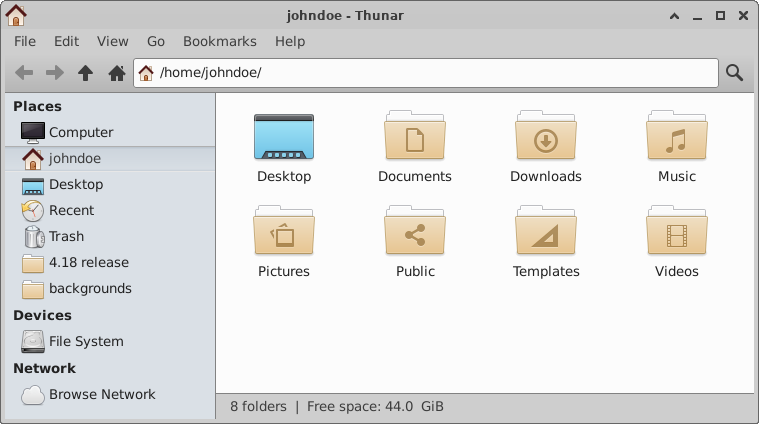This is an old revision of the document!
The File Manager Window
By default the file manager window consists of a shortcut pane on the left side, the main area on the right and a pathbar above the main area.
| The File Manager Window |
|---|

|
The Shortcut Pane provides shortcuts to different folders on your system. The first shortcut will lead to your Home Folder, the folder you store all your personal data, and will therefore have the name of the current user. The second shortcut will take you to the trash bin, which stores deleted files that can be recovered later. The third shortcut takes you to the Desktop Folder, which contains the files and folders that are displayed on the desktop. The fourth shortcut will take you to the root of your file system – you may want to explore it a bit, even though it may be confusing to you if you are new to Linux/Unix. Just click on the different folders and see what is inside.
Below the File System shortcut, the removable drives and media will be displayed. In the screenshot above, you can see a Floppy Drive shortcut. Click on these shortcuts to access the data stored on the removable drives and media. See the section called Using Removable Media for further details.
The remaining shortcuts are user defined. Add your own shortcuts by simply dragging folders to the Shortcuts Pane. This will allow you to access important folders instantly. To remove a previously added shortcut, right-click on the shortcut and choose Remove Shortcut. To rename a previously added shortcut, right-click on the shortcut and choose Rename Shortcut. Note that these actions affect only the shortcut, not the folder referenced by the shortcuts.
The main area will always display the contents of the current folder. Double click on folders to enter them, and right-click on files or folders to get a context-menu offering some choices of what to do with it. Select multiple files by dragging a rectangle over them with the mouse. Alternatively, select one file, hold down the Shift key, and increase or decrease the selection using the arrow keys.
The pathbar will always show the path you took to get to the folder you are currently at. You can click on any pathbar button to change to the folder it represents. Right-click on a pathbar button to bring up a context-menu with some options.